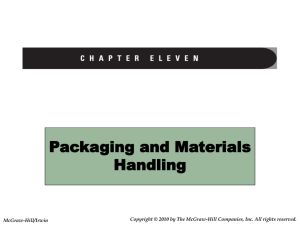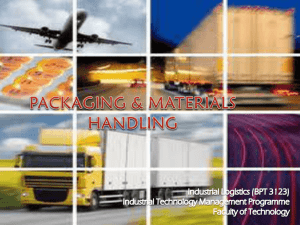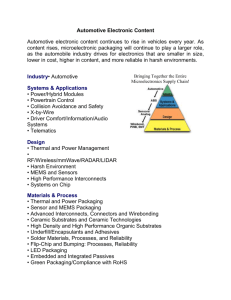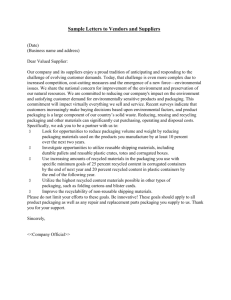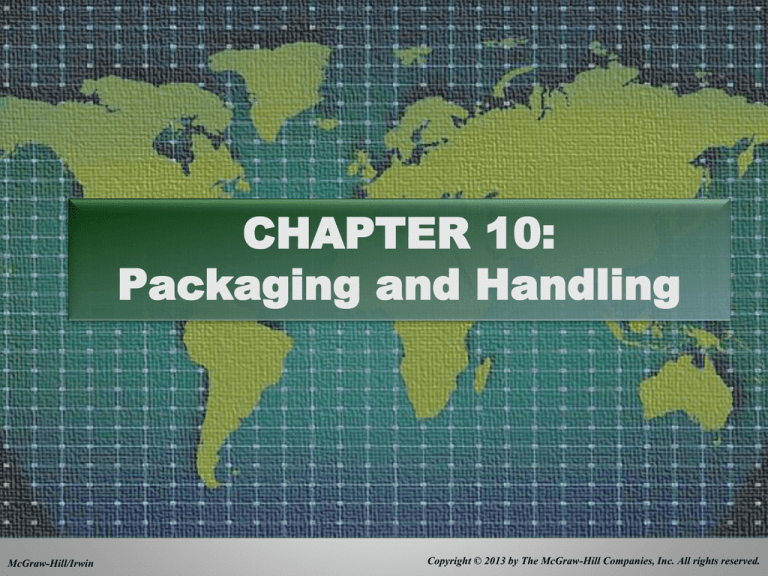
CHAPTER 10:
Packaging and Handling
McGraw-Hill/Irwin
Copyright © 2013 by The McGraw-Hill Companies, Inc. All rights reserved.
The Future of Paper and Packaging
• Video link (11:02 min.) starting at 16:45
http://www.youtube.com/watch?v=djSWPET40Ro
10-2
Overview of packaging and handling
• Packaging Perspectives
• Packaging for Materials
Handling Efficiency
– Package design
– Unitization
– Communication
• Handling
–
–
–
–
–
–
Basic handling considerations
Mechanized systems
Semi-automated systems
Automated systems
Information-directed systems
Special handling considerations
10-3
Packaging perspectives
• Packaging is typically viewed
as
– Consumer - marketing focus
– Industrial – logistics focus
• Master cartons are containers
used to group individual
products
• Containerization or
unitization refers to grouping
master cartons into larger units
for handling
• Grouped master cartons are
called unit loads
10-4
Role of packaging in logistics
• Unitization—modular
packaging
• Handling—appropriate for
automation?
• Security—can package be
sealed to detect break-in
• Stowability—cube efficiency
• Information—identification and
tracking
• Protection—spoilage or
damage
10-5
Packaging for material handling efficiency
• Package design using standard configurations and order quantities
facilitates efficiency
– Cube out of vehicle results in shipping “full” without reaching
weight limit
– Weigh out of transport vehicle results in shipping air in space
that can’t be filled with product
– Cube and weight minimization are special challenges of mail
order and e-commerce
• Unitization is the process of grouping cartons into unit loads
• Communication role is to identify package contents for all channel
members
10-6
Illustration of four standard master carton
sizes to achieve modular compatibility
Figure 10.1 Example and Benefits of Modular Packaging
10-7
Unitization has the basic objective of increasing
handling and transport efficiency
• Unit loads take 1/5 the
time required for manual
loading and unloading
• Unitization methods
– Rigid containers
• Air Freight Containers
• Sea-Land Containers
• Returnable Racks
– Flexible containers
• Pallets
• Slipsheets
10-8
Benefits of rigid containerization from Table
10.1
•
•
•
•
•
•
Improves overall material movement efficiency
Reduces damage in handling and transit
Reduces pilferage
Reduces protective packaging requirements
Provides greater protection from environment
Provides a shipment unit that can be reused many times
– Reduces waste
– Reduces need to dispose of the container
10-9
Illustration of a hardwood pallet
Figure 10.2 Example of Hardwood Pallet
10-10
Illustration of four basic patterns to tier
master cartons
Figure 10.3 Basic Pallet Master Carton Stacking Patterns
10-11
Communication functionality of packaging is
increasingly critical to identify and track packages
• Identification displays key logistical
info
– Manufacturer, product, container
global type, count, UPC, and EPC
• Tracking provides the ability to
determine the exact location of an
item
• Special handling instructions
– For example, glass, temperature
restrictions, stacking considerations,
or environment/safety concerns
• Technologies facilitating
communication include
– Bar Coding, RFID, GPS
– “Nested RFID” for items in a unit load
10-12
Basic handling considerations
• Method depends on the
materials!
• Bulk materials are handled
without master cartons
– E.g. powders/liquids,
– Need specialized
equipment
• Unit loads, containers and
master cartons can be
handled many ways
10-13
Principles of handling from Table 10.2
Equipment for handling and
storage should be as
standardized as possible
When in motion, the system
should be designed to provide
maximum continuous product
flow
Investment should be in
handling rather than stationary
equipment
Handling equipment should be
utilized to the maximum extent
possible
In handling equipment
selection the ratio of dead
weight to payload should be
minimized
Whenever practical, gravity
flow should be incorporated in
system design
10-14
Material handling systems require different
amounts of labor and capital investments
•
•
•
•
•
Manual sorting
Mechanized
Semi-automated
Automated
Information-directed
10-15
Manual systems for picking, sorting
and movement of inventory
• Labor-intensive
• Slow
• Human Limitations
– Repetitive
motion
– Strain injuries
• Higher error rates
10-16
Mechanized systems employ a wide range of
handling equipment
• Most mechanized systems
combine different handling
devices
• Moderate fixed and variable
cost with good flexibility
• Examples
–
–
–
–
–
–
Forklift
Rider pallet trucks
Towlines
Tractor trailers
Conveyors
Carousels
• Paperless picking
10-17
Semiautomated systems often supplement
mechanized equipment
• High fixed cost, low
variable cost with low
flexibility
• Examples
– Automated guided vehicles
(AGV)
– Sortation systems
– Robotics (see video)
• Build and breakdown unit
loads
Video link (1:03 min.)
http://www.youtube.com/watch?v=xT_sLWA5pq0
&feature=related
– Live racks
10-18
Automated systems now focus on high-rise
storage and retrieval
• Highest fixed cost, lowest
variable and labor cost with low
flexibility
• Potential to automate is the
elimination of direct labor by
substituting capital equipment
• Guiding principles from Table
11.2 do not apply
• Examples
Video of Andersen AS/RS system (2:44 min.)
http://www.youtube.com/watch?v=giaf76zBoYU
– Order selection systems
– Automated storage and retrieval
system (AS/RS)
10-19
Illustrated concept of a high-rise AS/RS
warehouse
Figure 10.4 AS/RS High-Rise Warehouse
10-20
Information-directed systems combine controls of
automated handling with flexibility of mechanized
• Moderate fixed and variable cost
with high flexibility and utilization
• Offers selected benefits of
automation without substantial
capital investment
• Main drawback is accountability
regarding work assignment
• Examples
– RF wireless (Wi-Fi)
Video link (0:49 min.)
http://www.youtube.com/watch?v=0zVfZbwx1vs
• Use lift trucks, RFID scanners and
data collection terminals
– Pick-to-light carousel system
10-21
Completely robotic facilities exist for
specialized situations
• Some bulk and container
loading/unloading facilities
have gone completely
robotic
– Example is the Port of
Brisbane in Queensland,
Australia
Video link (2:58 min.)
http://www.youtube.com/watch?v=OAHoCI-IAMA
10-22
Special handling considerations
• E-fulfillment
– Places special demands on a firm’s warehousing and materials
handling
• Environmental concerns
– Impact of equipment or hazardous materials
• Regulatory environment
– OSHA is extending its regulatory influence over warehouse
operations and technology
• Returns processing
– Traditionally done using manual methods
10-23
E-fulfillment demands influence warehousing and
materials handling in four ways
• Large volume of small orders
– Difficult to achieve economies of
scale in picking operations
• Wide range of products requires
large inventories
– Requires ability to receive and
merge a large number of small
orders rapidly
• People-intensive facilities
needed to provide flexibility in
picking
• Consumer expectations require
many activities within the
warehouse to be electronically
scanned and tracked
10-24

